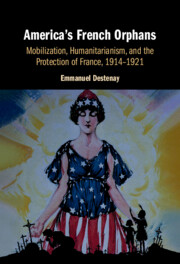Refine search
Actions for selected content:
115 results
4 - From Protest to Resistance (1967)
-
- Book:
- Waging Peace
- Published online:
- 03 November 2025
- Print publication:
- 13 November 2025, pp 119-180
-
- Chapter
- Export citation
7 - Nakba: The Displacement of the Medical Community
-
- Book:
- Palestinian Doctors
- Published online:
- 12 September 2025
- Print publication:
- 02 October 2025, pp 214-247
-
- Chapter
- Export citation
Chapter Seven - The Afro-Latin American Context
- from Part III - Research Paths: Cuba and Afro-Latin America
-
-
- Book:
- My Own Past
- Published online:
- 30 September 2025
- Print publication:
- 18 September 2025, pp 189-215
-
- Chapter
- Export citation
Who Stopped the Equal Rights Amendment?
-
- Journal:
- State Politics & Policy Quarterly ,
- Published online by Cambridge University Press:
- 12 September 2025, pp. 1-25
-
- Article
-
- You have access
- Open access
- HTML
- Export citation
10 - Civil Society Resistance to Democratic Backsliding
- from Part II - Civil Society, Social Media, and Political Messaging
-
-
- Book:
- Global Challenges to Democracy
- Published online:
- 01 May 2025
- Print publication:
- 15 May 2025, pp 196-214
-
- Chapter
- Export citation
Chapter 6 - On Manipulation in Politics
- from Part II - The Ethics
-
- Book:
- The Concept and Ethics of Manipulation
- Published online:
- 10 April 2025
- Print publication:
- 17 April 2025, pp 197-222
-
- Chapter
- Export citation
Citizen Advocacy: The Achievements of New Zealand's Peace Activism
-
- Journal:
- Asia-Pacific Journal / Volume 17 / Issue 19 / October 2019
- Published online by Cambridge University Press:
- 14 March 2025, e2
-
- Article
-
- You have access
- Open access
- Export citation
Mobilizing the Rights of Homeless EU Citizens in the Netherlands
-
- Journal:
- German Law Journal / Volume 25 / Issue 6 / August 2024
- Published online by Cambridge University Press:
- 24 January 2025, pp. 910-918
-
- Article
-
- You have access
- Open access
- HTML
- Export citation
5 - Property
- from Part II - A Tale of Three Cities
-
- Book:
- The Authoritarian Commons
- Published online:
- 21 December 2024
- Print publication:
- 09 January 2025, pp 61-82
-
- Chapter
- Export citation
15 - The End of the German Empire
-
- Book:
- The German Empire, 1871–1918
- Published online:
- 06 December 2024
- Print publication:
- 02 January 2025, pp 546-604
-
- Chapter
- Export citation
“The Anti-Woke Academy”: Dutch Far-Right Politics of Knowledge About Gender
-
- Journal:
- Politics & Gender / Volume 21 / Issue 2 / June 2025
- Published online by Cambridge University Press:
- 13 December 2024, pp. 195-219
-
- Article
-
- You have access
- Open access
- HTML
- Export citation
8 - War and the State in the Pacific
- from Part III - Case Studies
-
- Book:
- Bringing War Back In
- Published online:
- 14 November 2024
- Print publication:
- 21 November 2024, pp 185-222
-
- Chapter
- Export citation
9 - War and the State in Mexico and Central America
- from Part III - Case Studies
-
- Book:
- Bringing War Back In
- Published online:
- 14 November 2024
- Print publication:
- 21 November 2024, pp 223-262
-
- Chapter
- Export citation

America's French Orphans
- Mobilization, Humanitarianism, and the Protection of France, 1914–1921
-
- Published online:
- 24 October 2024
- Print publication:
- 13 June 2024
Discrimination and Political Engagement: A Cross-national Test
-
- Journal:
- Journal of Race, Ethnicity and Politics / Volume 9 / Issue 3 / November 2024
- Published online by Cambridge University Press:
- 24 October 2024, pp. 472-487
-
- Article
-
- You have access
- Open access
- HTML
- Export citation
7 - Political Participation
- from Part III - The Inputs of Democratic Decision-Making in a Racially Divided America
-
- Book:
- Race and Inequality in American Politics
- Published online:
- 09 November 2024
- Print publication:
- 17 October 2024, pp 216-261
-
- Chapter
- Export citation
Ethnopolitics in a Mining Enterprise in Crisis: Revisiting the Albanian Miners’ Protests in Late Socialist Kosovo
-
- Journal:
- Nationalities Papers / Volume 53 / Issue 3 / May 2025
- Published online by Cambridge University Press:
- 19 August 2024, pp. 600-618
-
- Article
-
- You have access
- Open access
- HTML
- Export citation
Chapter 26 - Terrorism
- from Part 4 - The new agenda: Globalisation and global challenges
-
-
- Book:
- An Introduction to International Relations
- Published online:
- 31 August 2024
- Print publication:
- 12 August 2024, pp 345-357
-
- Chapter
- Export citation
Introduction
-
- Book:
- America's French Orphans
- Published online:
- 24 October 2024
- Print publication:
- 13 June 2024, pp 1-17
-
- Chapter
- Export citation
Chapter 2 - Mobilizing Support for France’s Fatherless Children
-
- Book:
- America's French Orphans
- Published online:
- 24 October 2024
- Print publication:
- 13 June 2024, pp 48-84
-
- Chapter
- Export citation
